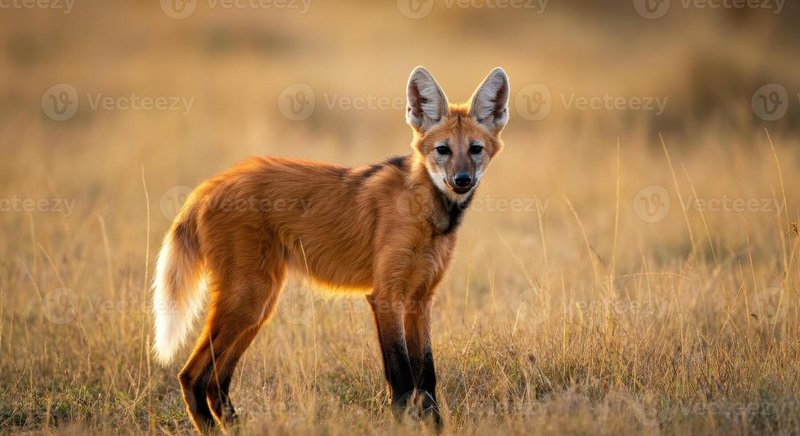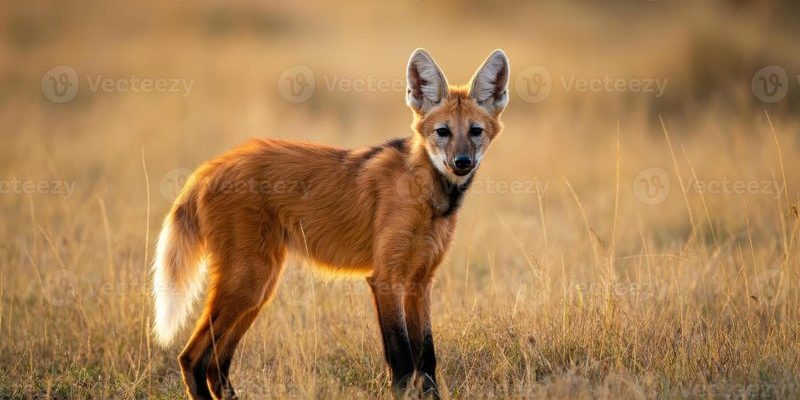
The Maned Wolf is one of those animals that captures your imagination, almost like a character out of a storybook. With its long legs, striking reddish-brown coat, and a distinctive mane that stands upright when threatened, this fascinating creature roams the grasslands and savannas of South America. Unlike anything you’d see in your backyard, the Maned Wolf is not just another dog; it has unique traits that set it apart from its canine relatives. Think of it as the elegant giant of the canine world, striding gracefully across open terrain.
You might be curious about where you can find these intriguing animals. The Maned Wolf primarily inhabits areas like Brazil, Argentina, and Paraguay. They prefer open grasslands and forest edges, where they can roam freely in search of food. Their social structure is a bit of a mystery, as they tend to be solitary creatures but have been known to come together during mating season. This blend of reclusive behavior and fascinating adaptability makes the Maned Wolf a captivating subject of study.
Physical Characteristics of the Maned Wolf
The physical appearance of the Maned Wolf is nothing short of extraordinary. Standing about 3 feet tall at the shoulder and weighing anywhere from 50 to 75 pounds, these animals are often mistaken for a fox or a small wolf at first glance. However, their long legs set them apart, giving them a lanky, almost graceful look. Their coat is primarily a reddish-brown color, which can sometimes appear more golden, especially in the sunlight. The contrasting black legs add to their unique aesthetic—imagine a tall, slender dancer elegantly moving through a field.
One of the standout features of the Maned Wolf is its mane, which runs along its neck and stands erect when the animal feels threatened. This mane isn’t just for show; it serves a dual purpose: it makes the wolf look larger to potential threats and can also help communicate with other wolves. Picture a cat puffing up when it’s scared—this is somewhat similar but in a much more striking form.
Habitat and Range
As mentioned earlier, the Maned Wolf thrives in the open grasslands and savanna ecosystems of South America. They are highly adaptable, which means they can also be found in scrub forests and even near agricultural lands. Their range extends across several countries, primarily Brazil, Argentina, and Paraguay, with some populations in parts of Bolivia and Peru. Imagine driving through the Brazilian countryside and spotting one of these regal creatures silhouetted against the sunset.
Their habitat is crucial for survival, as it provides the space they need to hunt and explore. Unfortunately, like many other wildlife species, the Maned Wolf faces threats from habitat loss due to agricultural expansion and urbanization. Conservation efforts are essential to protect their natural environments so that future generations can experience this magnificent creature in the wild.
Diet and Hunting Behavior
On to the Maned Wolf’s diet, which is as fascinating as the animal itself. Unlike most canines, the Maned Wolf’s diet is highly varied and includes fruits, small mammals, birds, and even insects. In fact, they are known for their love of a particular fruit called the lobeira or wolf apple, which makes up a significant portion of their diet. Imagine a creature that forages for its food like a blend between a wolf and a fruit-loving bird!
When hunting, the Maned Wolf uses its keen sense of hearing to locate prey, often listening for the sounds of small animals rustling in the grass. Once they identify their target, they rely on their long legs to sprint quickly and cover ground efficiently. The combination of stealth and speed is a crucial part of their hunting strategy. You can picture them weaving in and out of grasslands like a dancer, merging grace with purpose.
Reproduction and Social Structure
The social structure of the Maned Wolf is intriguing and somewhat puzzling. While they tend to be solitary, they come together during the mating season, which usually occurs between March and May. After a gestation period of about 60 to 65 days, the female gives birth to a litter of 2 to 4 pups, which she raises primarily with the help of the male. This is a bit of a shift from typical canine behavior, where both parents are usually present in raising offspring.
Once the pups are born, they remain in the den for several weeks. As they start to venture out, they’re curious about the world around them. Observing the way the parents interact with the pups provides a glimpse into the nurturing side of these majestic creatures. It’s like watching a live family drama unfold in the heart of the savanna—a mix of challenge and tenderness, all rolled into one.
Conservation Status
Unfortunately, the Maned Wolf is classified as Near Threatened on the IUCN Red List. Loss of habitat due to agricultural expansion and deforestation poses significant risks to their population. Additionally, they sometimes fall victim to road traffic and are occasionally hunted. Conservation organizations are working diligently to study these wolves and promote awareness about their plight. Imagine campaigns aimed at teaching farmers and local communities the importance of coexistence with wildlife.
Efforts are being made to protect their habitats through wildlife corridors that allow for safe movement between different areas. Every bit of effort counts in ensuring that future generations can also enjoy the sight of the elegant Maned Wolf as it gracefully strides across the landscape.
Fascinating Facts about the Maned Wolf
| Size: | 3 feet tall at the shoulder |
| Weight: | 50 to 75 pounds |
| Diet: | Fruits, small mammals, birds, and insects |
| Lifespan: | Up to 12 years in the wild |
| Habitat: | Grasslands and savannas of South America |
The Maned Wolf is a truly remarkable creature that deserves our attention and protection. Its unique appearance, combined with its fascinating dietary habits and social structure, makes it a standout member of the animal kingdom. As we learn more about these enigmatic wolves, we can also appreciate the beauty of biodiversity and the importance of conservation efforts. The more we understand, the better equipped we are to help protect these majestic animals and their habitats for generations to come.
FAQ
Where can I find Maned Wolves in the wild?
Maned Wolves primarily inhabit the grasslands and savannas of South America, with significant populations in Brazil, Argentina, and Paraguay. You may catch a glimpse of these striking animals in nature reserves or wildlife parks dedicated to preserving their habitat.
What do Maned Wolves eat?
Maned Wolves have an interesting diet that includes fruits, small mammals, birds, and insects. They are known for their fondness for the lobeira fruit, which is a key part of their diet. This fruit is not only delicious for the wolves but also plays a role in the ecosystem by helping to spread seeds.
How do Maned Wolves communicate?
Maned Wolves communicate using a variety of vocalizations and body language. They make high-pitched calls, much like a bird, which can travel long distances. Additionally, physical signals, like raising their manes, can indicate whether they feel threatened or are ready to mate.
Are Maned Wolves social animals?
While Maned Wolves are generally solitary, they do come together during the mating season. They form temporary pairs for breeding and share the responsibilities of raising their pups, making them somewhat social during specific times of the year.
What threats do Maned Wolves face?
Maned Wolves face several threats, primarily habitat loss due to agricultural expansions and urban development. They are also at risk from road traffic and hunting. Conservation efforts are crucial to protect their populations and habitats.
What is the lifespan of a Maned Wolf?
In the wild, the lifespan of a Maned Wolf typically ranges up to 12 years. However, in captivity, they may live longer due to better living conditions and veterinary care.
Can Maned Wolves be domesticated?
Maned Wolves are wild animals and are not suitable for domestication. They have specific dietary and habitat needs that make them challenging to keep as pets. It’s best to appreciate them in their natural environment or via reputable wildlife sanctuaries.
How do conservationists help Maned Wolves?
Conservationists work to protect Maned Wolves through habitat preservation, creating wildlife corridors, and promoting education about the importance of coexistence with these animals. Their efforts help raise awareness and support for conservation initiatives.
Are there any notable myths or cultural references about Maned Wolves?
Yes, the Maned Wolf has been a part of local folklore in South America. Some cultures view them as mystical creatures, while others see them as symbols of wisdom. These stories reflect the deep connections people have with the wildlife in their regions.
What can I do to help Maned Wolves?
To help Maned Wolves, you can support conservation organizations focused on protecting their habitats, advocate for responsible land use practices, and raise awareness about the importance of wildlife conservation. Every action counts in preserving these majestic animals!

